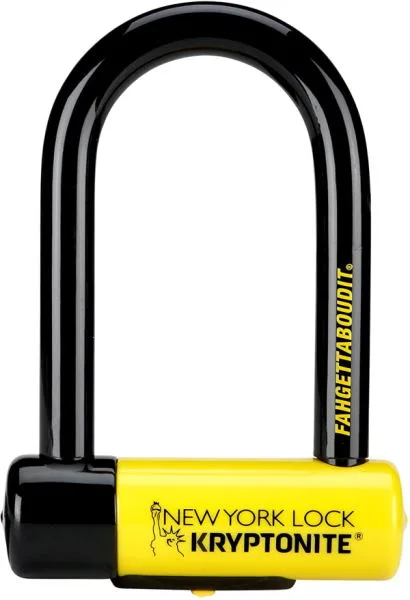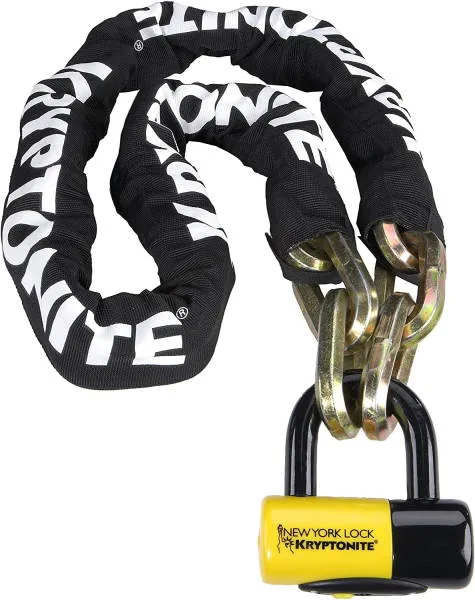Folding bike locks are becoming more popular with city bikers for a couple of good reasons. The idea is that they’re as portable as a cable, can be secured easier than a D lock, but are rigid and thick. But are they all they’re hyped up to be?
Why Bike Locks Suck
Getting the right bike lock is hard. We totally understand that having to take a few minutes every single time you jump off of your bike just to make sure you don’t lose it is annoying. We also know how much is sucks to get a bike stolen even when you were using the recommended bike locks.
We’re all told that the best common solutions are:
- to have a chunky U-lock around the frame, secured to a post. Then a further cable is attached to the U-lock which loops around other parts of the bike and tires.
- A chunky chain that loops through lots of the bike parts and then onto a secure post or bike rack.
The problem with the 1st is it can be annoying to set up and take down, and can be unstable on the bike. The problem with the second is mainly the weight, plus the time taken.
The idea of folding locks is that you can attach them to your frame easily and they stay stable. Setting up takes a few seconds of unfolding and then locking. Most also look thicker and harder to break than a cable. However…
Are Folding Bike Locks Any Good?
If you are an opportunist with bolt cutters or an angle grinder, folding bike locks aren’t as secure as a top-rated U-lock or thick chain. They might look better than a cable lock but the truth is that the metal is basically the same thickness.
Essentially, folding bike locks are easier to carry but not as secure as the options they’re meant to replace. We’d never recommend just a cable lock because they’re the easiest thing to break. For the same reason, there’s no point in getting a folding lock because they take about the same time to break.
The Problem With Folding Bike Locks
Folding bike locks can be defeated with a crowbar that pops open a rivet by pushing against the joints. They can also be broken with a fairly cheap nut splitter (see how) by forcing pressure into the joint and popping the rivet out.
There’s also the regular angle grinder or bolt cutter problem which isn’t any better with folding locks vs cable locks – despite what marketing might say. The lock where the key goes in are also very small and susceptible to drilling or just plain rake picking.
Folding bike locks also suffer from being rigid and easy to hold in place. With a chain, it takes a bit of manipulation or an extra hand to hold it in place to cut properly. Folding bike locks are quite to easy to push on and cut without moving about.
This all holds up to testing as there are no folding bike locks with the Sold Secure Diamond rating. So the answer to “are folding bike locks any good”, or “are folding locks secure” is basically no.
That being said, be aware that even the best locks can still be broken with the right tools and expertise.
So What Bike Lock Should I Get?
If you’ve just dropped a fair chunk of cash on an E-Bike, or you just don’t want to waste money on replacing your daily rider – get a quality bike lock solution. We recommend getting a U-Lock that has been rated Diamond by Sold Secure, plus a thick chain to go with it.
This means you can secure the frame and front wheel to a post with the U-lock, then thread the rest of the parts of the bike with the chain to the U-lock. It deters any opportunists, and makes any more determined thieves think twice.
If you’re going to buy a lock, buy once instead of upgrading every time they get broken.
Top Pick – Kryptonite New York Fahgettaboudit Chain & U-lock
- 14mm manganese steel links & 15mm shackle
- Sold Secure Diamond rating (highest)
- 3.25′ / 100cm long
- Heavy at 10.8 lbs / 4.91 kg
With a 14mm chain and a Kryptonite U-lock, this is basically the best you can get as a combo. A tried and tested combo with quality metal, lock, and Kryptonite’s warranty and LED light key. This will stand up to all but the most determined scumbags.
If you are absolutely determined to get the best, upgrade to the 18mm version of this lock below.
Kryptonite New York Fahgettaboudit U-lock

- 18mm Thick
- Sold Secure Diamond rating (highest)
- Pick-resistant Disc Cylinder
- Double Bolted
- Warranty & Key Safe Program
- Heavyish at 4.5lb / 2kg
- No included mount
- Small at 3.25″ x 6″
This is basically the best U-lock available on the market. It’s expensive but worth every penny. The big pluses are just the overall thickness of the shackle and cylinder. This is an updated version that’s Diamond rated by Sold Secure, a company who test all types of motorbike and bike locks.
It’s also fixed a few small design issues so the lock is less likely to rust or get first trapped. Combine this with a hefty chain and your bike is going nowhere fast (unless you want it to). Pair it with the lock below for the ultimate security or get a smaller version of this with a chain ready to go.
Kryptonite Evolution Series 4

- 10mm manganese steel links
- Sold Secure Diamond rating (highest)
- 63″ / 160cm long
- Used by LockPickingLawyer
- Heavyish at 9.6lbs / 4.35kg
If you’re in the market for a hefty chain lock on its own, this is the one to go for. Made by the same reputable Kryptonite brand and featuring 10mm hardened manganese steel links. This thing is great for annoying the hell out of people trying to cut with angle grinders.
If you’re worried about your expensive E-Bike getting stolen or damaged, you can get cover to help out replacing or repairing
– Read more about Insurance For Electric Bikes
Tips For Locking Your Bike
- Make sure to lock as many parts of the bike as you can. With a longer U-lock tray and get the frame and one wheel attached to the post. With a shorter one just the frame. Use the chain or cable to thread the rest
- Make sure the bike rack is secure, ideally cemented to the ground, and not cut somewhere. Avoid signposts or anything flimsy
- Angle the bike lock downwards so the keyhole is hard to access. This takes a bit of thinking but stops people from seeing what they’re doing when trying to pick the lock
- Park in a busy area near store or building security, or CCTV. You’d be surprised how blatant some thieves are, but this helps.
How Do Bikes Most Commonly Get Stolen?
There are really two types of thefts and thieves: opportunists, and targeted. The opportunists are looking for any bike that looks easy to get away with, and the targeted thieves care less about ease and more about value.
The opportunists are the easiest ones to dissuade by simply having a setup that will take them too much time, or a setup that’s better than other bikes around. Most thieves want to get away with your bike in under a couple of minutes before they attract attention. You’d be surprised how many do.
Related Reads
– How Fast Do Electric Bikes Go?
– Top 6 Best Electric Bike For Heavy Riders
The Main Methods Thieves Used To Steal Bikes
I Was Gone 10 Seconds!
Always lock your bike if you are not sat on it. Even if you’re just picking up a McDonalds order, popping in to drop off a package, or saying hi to a mate. Always assume someone is looking out for a bike to walk off with.
Locked To What?
Check what you are locking your bike to. Thieves sometimes cut bike racks and tape them over, so they simply pull the thing apart and bypass your lock. Bike racks that are bolted to the ground can sometimes be undone, some are just heavy enough that it’s hard to pick the whole thing up – but not impossible.
Low posts are also easy to pull a bike over the top of in a few seconds. Some posts with signs that can be easily removed and replaced are hotspots.
Poorly Locked
You don’t lock your bike properly so the thief can disassemble it and put it back together, or leave one part. Common when just locking by the handlebars, seatpost, or wheel only. A U-lock and chain should stop this, or a U-lock and cable will help.
Cheap Locks
Cheap combo locks can literally be pulled open by hand with enough force or are trivial to find the right code by pulling the lock apart and twisting until the dial stops, then moving to the next. Really, it’s that simple.
Bolt Cutters
This is by far the most common method thieves use. A decent pair of bolt cutters can snip through most cable locks and folding locks in under a minute. The force needed isn’t much with a long pair of bolt cutters, and you’d be surprised how hard it is to spot if it’s not under your nose.
The problem with folding locks is that although they look thick and sturdy, you only really have 2-3 mm of metal underneath the rubber. That really isn’t much and functionally isn’t hard to break than more cable locks.
Hacksaws & Angle Grinders
A hacksaw will do the job of cutting through a U-lock with enough time and grit. However, portable battery-powered angle grinders are the common tool for the more dedicated bike thief.
These can cut basically any lock – from a cable in seconds, to the top-rated U-lock or chain in a minute or two. The problem with this is that they’re louder, can make sparks, and take just a bit longer than most thieves are comfortable with.
Do Bike Locks Get Picked?
Though lock-picking videos and demos are commonplace, and it’s fairly simple to learn to pick bike locks, it’s actually not that common. Most of the time it’s faster, cheaper, and much easier to just break the lock.
Even in the busiest places in the world like New York City, thieves will happily use angle grinders and bolt cutters in the middle of the street.

